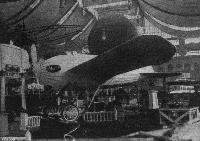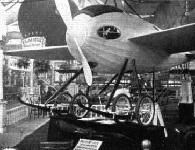P.Lewis British Aircraft 1809-1914 (Putnam)
Piggott Monoplane
The Piggott Monoplane was built by Piggott Brothers and Co. Ltd., 220-224 Bishopsgate. London, E.C., and was exhibited at the Olympia Aero Show of 1911. It was remarkably well streamlined, with the pilot and passengers completely enclosed in the fabric-covered fuselage. Slits were provided for their vision, and doors gave access to the cabin. The four-cylinder 80 h.p. Vivinus engine was concealed within the nose, with its attendant radiator mounted above and shaped to fit the contours of the fuselage. The four main wheels of the undercarriage were mounted in line abreast, with a further wheel at the rear under the tail. All control wires were duplicated in case of failure.
The machine did not fly in its original form, and was modified late in 1911 to have an open cockpit. In November, 191 I, it was tested at Hendon by S. C. Parr, and left the ground after a short run at high speed but damaged the undercarriage upon landing. Early in 1912 the landing-gear was rebuilt and strengthened. Span, 30 ft. 6 ins. Length. 24 ft 6 ins. Weight empty, 850 lb. Weight loaded, 1,400 lb.
Показать полностью
M.Goodall, A.Tagg British Aircraft before the Great War (Schiffer)
Deleted by request of (c)Schiffer Publishing
PIGGOTT monoplane
This machine was exhibited at the Olympia Aero Show in March 1911, with a fully enclosed cockpit. However, before it was tested at Hendon by S.C. Parr, it was modified to provide an open pilot's cockpit. During the tests the machine left the ground, but the undercarriage was damaged on landing. Although the damage was repaired, there were no further reports and the machine was abandoned.
As originally built, the Piggott monoplane had a light body totally enclosing the engine, pilot and passengers, who gained access to the interior cabin through a door in the underside; the only vision was through portholes. The engine was set back in the fuselage and required an extension shaft to carry the propeller, which had a streamlined boss to blend into the lines of the body. The radiator was shaped to lie on top of the front fuselage. A twin skid Farman-type undercarriage, with two pairs of rubber sprung wheels and a large tail wheel were fitted. A rather small rudder, elongated tailplanes and a one piece elevator comprised the tail unit. Lateral control was by warping, and all control cables were duplicated.
Power: 80hp Vivinus four-cylinder inline water-cooled.
Data
Span 30ft 6in
Weight 850 lb.
Length 24ft 6in
Weight allup 1,400lb.
Max speed 75 mph
Показать полностью
Jane's All The World Aircraft 1913
PIGGOTT. Piggott Bros. & Co., Ltd., 220, 222 & 224, Bishopsgate, London, E.C. This well-known firm of shed makers built a novel biplane in May, 1910 (details Flight, May 21st, 1910), and in 1911 a monoplane with enclosed body (Flight, April 1st, 1911). In 1912, both were disposed of, and the firm is not proceeding with its experiments. It has, however, a staff of skilled mechanics and a great deal of floor space for the construction of aeroplanes to specifications.
Показать полностью
Журнал Flight
Flight, April 1, 1911.
Third International Aero Exgibition at Olympia - 1911.
THE EXHIBITS ANALYSED.
<...>
At Olympia this year, then, stream-line bodies are the predominating feature in design. In the degrees of completeness they range all the way from the new Piggott monoplane which has every part of the body, the engine, pilot and passenger completely enclosed in a large torpedo-shaped casing with a hemispherical head. This represents the extreme development of the stream-line idea and it will be interesting to watch how far this whole-hearted adoption of a good principle works out in practice. Generally speaking such things are best evolved by degrees, and we do not doubt that it will be necessary to cut a few more holes in the Piggott shell before it satisfies the requirements of the average pilot. It will, at any rate, take, we should imagine, some little time to get used to being completely boxed in, for even as it is, with orthodox machines, aviators often complain of impeded vision. On the Piggott machine the outlook is entirely through windows made of insoluble gelatine, and the passenger and the engine are both situated in front of the pilot. The propeller boss, which is conical, forms a revolving pointed nose on the otherwise hemispherical head of the body.
<...>
Flight, April 19, 1917.
THE "TOTALLY ENCLOSED" AEROPLANE.
<...>
Apart from such early designs as the Henson already referred to, one of the first, if not, indeed, the very first, totally enclosed in the fuselage covering, was the Piggot monoplane exhibited at the Olympia aero show in 1911. This machine, as our illustration shows, had a stream-line body, even to a casing round the propeller boss, and it is, in point of fact, a debatable point whether the designer was primarily concerned with providing comfort for the passengers or obtaining maximum efficiency by stream-lining everything to the greatest possible extent. Be that as it may, the occupants were enclosed in the stream-line body which they entered through circular openings in the floor. Presumably these same openings served to give a view in a downward direction. An additional opening was provided under the engine near the nose, and windows on each side of the engine were to give the passenger a view directly forward. It is quite evident, in view of modern knowledge, that the pilot's range of vision was totally inadequate, and as a matter of fact, when the machine was ultimately tried, an opening was cut in the top of the body, through which the pilot's head projected. The machine was not a very great success, but we should hesitate to put this down to the fact that it was totally enclosed. Rather is it to be assumed that the chief trouble was insufficient power.
<...>
Показать полностью






